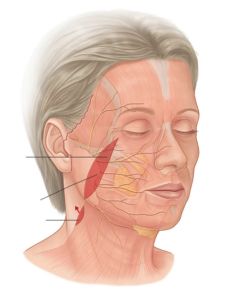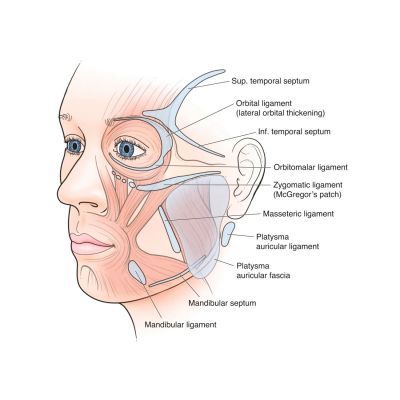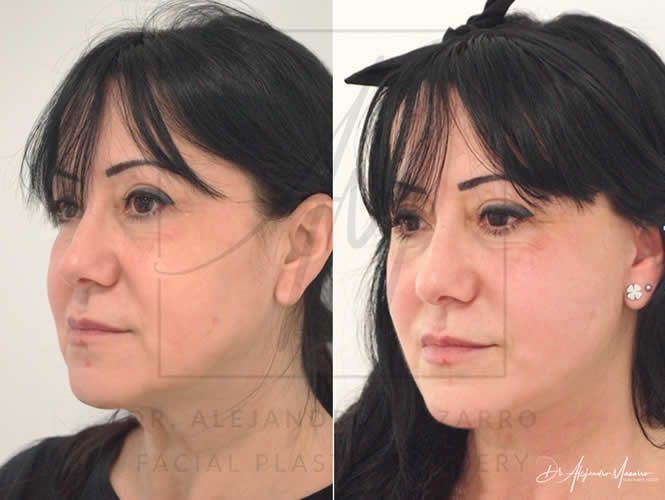Deep Plane Facelift in Barcelona
The Art of Natural Rejuvenation
Keep reading and discover the most advanced technique for achieving natural, long-lasting results: the Deep Plane Facelift
1st consultation
In-person vs. Online
Location
Barcelona
Anesthesia
General or intravenous sedation
Hospital stay
Overnight or outpatient
Recovery period
15 days
Recovery
Pain-free
Sport
After 1 month
Financing
Available through Tu Medicina Financiada
I want to look younger, not different
If you’re considering a facelift, you’ve probably encountered different techniques and terms that might seem confusing. Let me explain the basic fundamentals of facial anatomy, and you’ll understand why the Deep Plane Lift is exactly what you need if you’re looking to rejuvenate naturally.
Facial Anatomy
Let’s start with two fundamental structures to understand what happens with aging and why classical techniques can’t deliver the results you’re looking for:
- the SMAS
- the retaining ligaments
The SMAS
The SMAS (Superficial MusculoAponeurotic System of the face) is a tissue firmly attached to the skin that lies just above the facial mimetic muscles.
Over time, the skin and SMAS descend as a unit, sliding relative to the deep tissues (facial muscles), creating nasolabial folds and marionette lines.
Classical techniques (SMAS lift) are based on lifting the skin and pulling the SMAS. But excessive traction causes mouth distortion, while moderate traction fails to reposition the cheek. Why?
The Retaining Ligaments
Unlike the posterior half of the face, the anterior half is supported by retaining ligaments that connect the facial muscles, SMAS, and skin.
Just as skin loses its elasticity, these ligaments weaken over time, causing the cheeks to descend and blurring the once-crisp jawline.
Now that we understand facial anatomy, let’s explore what makes the Deep Plane Lift revolutionary.
Classical techniques: the SMAS lift
Traditional facelift techniques (SMAS plication, SMASectomy, MACSLift) rely on lifting the skin extensively and tightening the SMAS layer. However, they leave the retaining ligaments untouched.
This oversight has significant consequences. Without releasing these ligaments, the results are limited, as the lift can’t effectively address nasolabial folds or marionette lines. That’s why surgeons often resort to fat transfer (lipofilling) to compensate for inadequate lifting in the front of the face – precisely where aging signs are most prominent.
However, while fat transfer can add volume, it cannot lift or reposition sagging tissues – it merely fills without addressing the underlying problem.
The end result? Often an overdone appearance from excessive skin tension, visible scars, and that obvious “pulled” appearance that patients fear most.



What is a Deep Plane Facelift?
And why is it superior to any other technique
Natural Results
Unlike traditional techniques that simply pull tissues tight, the Deep Plane Lift represents a revolutionary approach: it restores your facial tissues to their youthful position, eliminating the need for additional fillers. Think of it as turning back time rather than creating artificial tension.
To achieve this, the retaining ligaments must be released – an essential step to reposition cheek fat and correct sagging in the anterior part of the face.
Deep Plane Facelift is not about creating tension; it’s about restoring your natural anatomy.

The Science Behind the Art
The anterior portion of the face has always been the holy grail of facial rejuvenation surgery. Traditional techniques can’t effectively reach this area because they avoid the intricate network of retaining ligaments that must be precisely released to achieve optimal results.
Think of these ligaments as a complex maze guarding the path to true rejuvenation. Without proper anatomical knowledge and specialized training, navigating this territory would be like trying to find your way through a labyrinth blindfolded.
Thanks to the groundbreaking work of anatomists like Dr. Bryan Mendelson and pioneering surgeons like Dr. Neil Gordon and Dr. Andrew Jacono, we now have a precise roadmap through this intricate anatomy. This knowledge allows us to safely achieve what was once considered impossible.
A More Sophisticated Approach
The Deep Plane Lift represents the pinnacle of facial rejuvenation surgery. By strategically releasing key ligaments, we can access and rejuvenate the areas where aging is most visible – something traditional techniques simply cannot achieve.
What sets this technique apart is its respect for your natural anatomy. Unlike traditional facelifts that separate and stretch the skin and SMAS independently, the Deep Plane approach maintains their natural relationship.
The result? Less swelling, faster recovery, and most importantly, a naturally refreshed appearance that looks like you – just years younger.
While traditional facelifts pull skin and superficial tissues tight – often creating that dreade “pulled
look” everyone fears – the Deep Plane technique works at a deeper level, restoring tissues to their youthful
position. Think of it as reversing time while preserving what makes you uniquely you: your natural
expressions and authentic appearance.
Before & After Gallery
Deep Plane Facelift Before & After
Curious to see what we can achieve together?
While these cases showcase some of my results, during your consultation we’ll review many cases,
focusing on those that most closely match your facial features and aesthetic goals.

Resultados al mes

Resultados a los 7 días

Resultados al año

Resultados a los 5 meses

Lifting cervicofacial de tipo Deep Plane – Resultados a los 5 meses

Lifting cervicofacial de tipo Deep Plane – Resultados a los 5 meses

Resultados a los 9 días

Lifting cervical – Resultados a las 5 semanas

Lifting cervical – Resultados a los 3 meses

Lifting cervical – Resultados a los 2 meses

Lifting cervicofacial de tipo Deep Plane – Resultados a los 3 meses

Lifting cervicofacial de tipo Deep Plane – Resultados a los 3 meses

Lifting facial de tipo Deep Plane – Resultados a las 2 semanas

Lifting facial de tipo Low SMAS – Resultados a los 7 días

Resultados a las 3 semanas

Resultados a los 9 días

Resultados a los 3 meses

Resultados a los 4 meses

Resultados a los 4 meses

Resultados a los 7 días

Resultados a los 15 días
What’s recovery really like?
You’ll be pleasantly surprised.
One of the most remarkable aspects of the Deep Plane technique is its comfortable recovery process. Unlike traditional facelifts, most patients experience minimal discomfort.
How minimal? Most of my patients manage perfectly well with just Paracetamol.
Of course, as with any surgical procedure, you can expect some swelling and bruising. While everyone’s healing journey is unique, I typically recommend planning for about 15 days of taking things easy.
Your safety comes first – always.
For suitable candidates, we can explore the option of intravenous sedation. However, in many cases, general anesthesia provides the safest environment for your procedure.
We typically reserve intravenous sedation for surgeries under 3 hours. For longer procedures, or if you have any underlying health conditions, general anesthesia will be my recommendation.
Throughout your surgery, you’ll be in the expert hands of my trusted anesthesiologist, whose sole focus will be your safety and comfort.
Let me be direct: this isn’t even a close comparison.
I haven’t performed a SMAS lift in years, and there’s a good reason why. Understanding facial aging helps explain this: your jawline loses definition because the retaining ligaments – nature’s support system – gradually weaken. This allows facial tissues to descend, creating jowls, nasolabial folds, and marionette lines.
SMAS lifts offer a temporary solution by tightening the skin, but they can’t address the root cause. The result? The classic facelift paradox: tight skin on the surface but persistent sagging underneath.
Let me share a simple mirror test that reveals everything.
A traditional SMAS lift pulls from the back of your face. Try this: standing before a mirror, place your
fingers just in front of your ears (red dots) and lift gently upward and back. Notice how this creates
tension but doesn’t fully address your central facial features?
Now experience the Deep Plane difference: place your fingers at your cheekbones and jawline (blue dots) and lift gently. See how this repositioning creates a more harmonious, natural result? That’s because we’re working through the retaining ligaments, exactly where aging occurs.
The mirror doesn’t lie – the difference is remarkable, isn’t it?

Preservation Facelift
Taking Deep Plane Surgery to the Next Level
Though recently published, this advanced technique has been part of our surgical approach for the past two years.
I’m privileged to collaborate with an elite group of facial rejuvenation specialists who share a common goal: continuously improving patient outcomes through innovation and shared expertise.
The result? The “Preservation Facelift” – a sophisticated enhancement to the Deep Plane technique that not only improves upon the already exceptional results of the Deep Plane technique but also offers a shorter recovery period.

Why choose me?
A Commitment to Excellence
Excellence in facial surgery demands hyperspecialization. Eight years ago, I made a decisive choice to focus exclusively on facial rejuvenation surgery. This wasn’t just a career decision – it was a commitment to achieving the highest possible standards in this sophisticated field.
Since then, I’ve immersed myself in mastering the most advanced techniques, constantly refining my skills to deliver the best possible results for my patients.
Cutting edge technique
Facial rejuvenation has evolved dramatically. While traditional techniques (MACS lift, SMASectomy, SMAS plication, high-SMAS, low-SMAS) remain common due to their simplicity, they’ve been surpassed by more sophisticated approaches. Few surgeons choose to master the more demanding Deep Plane technique – but the superior results make this dedication worthwhile.
As with any pursuit of excellence, the extra effort yields extraordinary rewards. The results achieved through Deep Plane lifting are simply unmatched by conventional techniques.
An Artistic Vision for Natural Beauty
Aesthetic surgery is where technical precision meets artistic vision. While some surgeons prefer dramatic transformations, my philosophy centers on natural-looking results.
When choosing your surgeon, ask yourself: do their results reflect the refreshed, natural look you envision?
If you’re seeking subtle, elegant rejuvenation that honors your natural features, you’ve come to the right place.
Alejandro Mazarro

Recently, there’s been a trend of surgeons taking a strong stance against fillers. The reality is more nuanced.
No treatment is inherently good or bad – success depends on choosing the right approach for your specific needs. Here’s what you need to know about fillers:
Hyaluronic acid can effectively:
• Soften nasolabial folds
• Restore volume to lips, cheeks, and chin
• Enhance specific facial features
However, it’s crucial to understand their limitations: fillers can add volume, but they can’t lift sagging tissues. Overuse leads to the dreaded “pillow face” – that artificial, overfilled look that ages rather than rejuvenates.
Remember: volume and lift are different things. Only surgery can reposition descended tissues.
In my practice, I’m often asked about non-surgical alternatives to facelifts. It’s understandable – the appeal of a ‘quick fix’ with minimal downtime is tempting. However, it’s important to understand both the potential and limitations of these options.
Thread Lifts: While they might offer temporary improvement in very early stages of aging, their results are short-lived. If you’re pulling your skin back in the mirror to see your desired result, you need something
more substantial than threads.
Ultrasound Treatments (HIFU): These can be excellent in specific cases, particularly for mild fat excess. However, patient selection is crucial. I’ve seen concerning cases where inappropriate ultrasound treatment led to premature aging through fat atrophy.
When appropriate, I’ll recommend them – but only if you’re a suitable candidate and surgery isn’t yet indicated.
The key to success? Choosing the right treatment at the right time.
I frequently meet patients who believe their age should dictate their choice of facelift technique. Many request mini-lifts, thinking they’re the appropriate “starter” procedure. This is a common misconception.
The reality is that mini-lifts cannot effectively address the key concerns most patients have: nasolabial folds, jowls, and neck laxity.
What makes the Deep Plane technique truly exceptional is its versatility. It can be precisely tailored to each patient’s needs, regardless of age. For younger patients, we can employ a more conservative approach while still leveraging the technique’s superior ability to reposition tissues naturally.
The term “mini-lift” is brilliant marketing, suggesting a simpler solution to facial aging. However, I must be honest: I don’t recommend it to any of my patients.
Here’s why.
While results may seem satisfactory initially, they’re short-lived. Once swelling subsides, tissue laxity returns, often leading to secondary surgery – more complex and costly than a primary Deep Plane lift.
As Dr. Neil Gordon wisely observes: “Everyone wants a mini-lift until they get one.”

Book your consultation with Dr. Mazarro.
We’ll need some photographs for a preliminary assessment to ensure you’re an ideal candidate for the procedure.

We’ll carefully analyze your unique facial anatomy and thoroughly discuss your aesthetic goals. We will then create together a individualized treatment plan specifically tailored to achieve the natural rejuvenation you’re seeking.

Take the time you need to reflect.
While this is a significant decision, you’ll feel confident when it’s right for you.

Enjoy looking as young as you feel!
What is a Deep Plane Facelift?

The Deep Plane technique represents the most advanced approach in facial rejuvenation surgery. Unlike traditional facelifts that rely on pulling the skin tight, this sophisticated technique repositions facial tissues to their natural position. The result? Natural, long-lasting rejuvenation without the “pulled” look of conventional facelifts.








